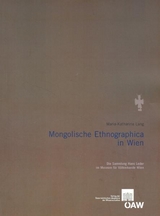Mongolische Ethnographica in Wien
Die Sammlung Hans Leder im Museum für Völkerkunde Wien
Seiten
2010
Verlag der österreichischen Akademie der Wissenschaften
978-3-7001-6760-0 (ISBN)
Verlag der österreichischen Akademie der Wissenschaften
978-3-7001-6760-0 (ISBN)
- Titel nicht im Sortiment
- Artikel merken
Die größte Sammlung mongolischer Ethnographica in Europa geht auf den österreichischen Forschungsreisenden Hans Leder (1848–1921) zurück, den entomologische Forschungen 1892 von Südsibirien in die Mongolei führten. Auf weiteren Reisen in die Nördliche Mongolei zwischen 1892 und 1905 begann Leder vorwiegend mongolischbuddhistische Ritualobjekte zu sammeln und zu erforschen. Ein Teil dieser Sammlung befindet sich im Museum für Völkerkunde Wien; weitere Sammlungsteile werden in ethnographischen Museen in Deutschland, Tschechien und Ungarn aufbewahrt. In dem auf einem Projektbericht basierenden Buch werden bisher unveröffentlichte Archivdokumente und Abbildungen von Objekten dieser Sammlung, ein Einblick in die Biographie des Sammlers und die verzweigte Geschichte der Sammlung sowie die Ikonographie der Artefakte publiziert. Die Einzigartigkeit der Sammlung liegt in der Momentaufnahme der religiösen Alltagskultur in der Nordmongolei um 1900. Dieser Teil der mongolischen Kultur wurde zunehmend verdrängt und in den späten 1930er Jahren zu einem großen Teil zerstört. Der Umgang mit sakralen Objekten und deren Bedeutung nach Einführung der Demokratie 1990 wird in dem vorliegenden Buch thematisiert.
The most extensive collection of Mongolian ethnographica in Europe goes back to the Austrian explorer Hans Leder (1848–1921). In 1892, his entomological studies led him from southern Siberia to Northern Mongolia. During further stays in Mongolia between 1892 and 1905, Leder collected and studied mainly Mongolian-Buddhist ritual items. A portion of his extensive collection is housed in the Museum of Ethnology Vienna, with further parts preserved in the major museums of ethnography in Germany, the Czech Republic and Hungary. This volume, based on a project report, releases previously unpublished archival data and depictions of museum artefacts, offers details about the collector’s biography and the intricate history of the collection, and discusses the artefacts’ iconography. The collection is unique as it represents a snapshot of everyday religious culture in Northern Mongolia at the turn of the 19th century. This part of Mongolian culture was increasingly repressed, and by the late 1930s it was nearly destroyed completely. The present publication also discusses the interaction with sacred artefacts and their meanings since the establishment of democracy in Mongolia in 1990.
The most extensive collection of Mongolian ethnographica in Europe goes back to the Austrian explorer Hans Leder (1848–1921). In 1892, his entomological studies led him from southern Siberia to Northern Mongolia. During further stays in Mongolia between 1892 and 1905, Leder collected and studied mainly Mongolian-Buddhist ritual items. A portion of his extensive collection is housed in the Museum of Ethnology Vienna, with further parts preserved in the major museums of ethnography in Germany, the Czech Republic and Hungary. This volume, based on a project report, releases previously unpublished archival data and depictions of museum artefacts, offers details about the collector’s biography and the intricate history of the collection, and discusses the artefacts’ iconography. The collection is unique as it represents a snapshot of everyday religious culture in Northern Mongolia at the turn of the 19th century. This part of Mongolian culture was increasingly repressed, and by the late 1930s it was nearly destroyed completely. The present publication also discusses the interaction with sacred artefacts and their meanings since the establishment of democracy in Mongolia in 1990.
| Erscheint lt. Verlag | 23.6.2010 |
|---|---|
| Reihe/Serie | Denkschriften der philosophisch-historischen Klasse ; 398 | Veröffentlichungen zur Sozialanthropologie ; 13 |
| Zusatzinfo | zahlr. Abb |
| Verlagsort | Wien |
| Sprache | deutsch |
| Maße | 210 x 300 mm |
| Gewicht | 310 g |
| Einbandart | Paperback |
| Themenwelt | Sozialwissenschaften ► Ethnologie ► Völkerkunde (Naturvölker) |
| Schlagworte | Hardcover, Softcover / Ethnologie/Völkerkunde • Maria-Katharina Lang • Mongilische Ethnographica • Museume Völkerkunde Wien • Sammlung Hans Leder |
| ISBN-10 | 3-7001-6760-1 / 3700167601 |
| ISBN-13 | 978-3-7001-6760-0 / 9783700167600 |
| Zustand | Neuware |
| Haben Sie eine Frage zum Produkt? |
Mehr entdecken
aus dem Bereich
aus dem Bereich
Schweden : Ambiguitäten verhandeln - Tolerieren als soziale und …
Buch | Softcover (2023)
Brill Schöningh (Verlag)
CHF 69,85
Buch | Softcover (2023)
transcript (Verlag)
CHF 75,60




